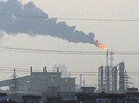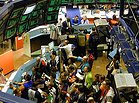Hungry City: How Food Shapes Our Lives
Carolyn Steel
Chatto & Windus, 2008
The End of Food: The Coming Crisis in the World Food Industry
Paul Roberts
Bloomsbury, 2008
Hungry City is a sinister real-life sequel to Animal Farm with the plot turned upside down by time in ways even George Orwell could not have foreseen. Its key image is the Pig Tower, a 21st-century Dutch invention for producing pork in custom-built city blocks, each 76 floors high, designed to house pigs in comfortable apartments with lavish bedding and ample rootling space on large, open-air balconies. “The towers,” according to the book, “would be powered by bio-gas digesters run on pig manure, and connected to a central abattoir to which the pigs would be moved by lift.”
This perfectly rational project would deliver a lifestyle not essentially different, as Carolyn Steel points out, from the conditions currently enjoyed worldwide by many urban human beings. She calculates that 1,000 huge, mixed “vertical farms” constructed in and around central London could feed the entire city. The savings (zero food miles, on-site waste disposal, no hidden pollution costs) take us back to something like the old sustainable style of farming still practised in England in 1945, when Animal Farm came out.
Orwell’s quaint old Farmer Jones, with his pony trap, hand milking and horse-drawn plough, had no machinery on his farm, nor any means of generating the electricity to work it. Sixty years later the industrial production, preservation, packaging and transport of food for the United Kingdom uses four barrels of oil per person per year (the United States needs nearly twice as much). London alone consumes the produce of a global hinterland over 100 times its own size, roughly equivalent to the whole of Britain’s currently cultivated farmland.
The speed of this transformation, together with its unprecedented scale and secrecy, makes its nature, let alone its consequences, difficult to grasp. For the first time in history, supply no longer has any clear relation to demand. Output, and the complex international infrastructure that supports it, is controlled exclusively by profit. Chronic over-consumption with its attendant ills (obesity, diabetes, heart trouble) keeps pace in one part of the world with starvation in others.
The figures are staggering. Wal-Mart currently dominates the global grocery trade with profits reckoned by the United Nations at the start of the century to be “bigger than the gross domestic product of three quarters of the world’s economies”. Today those profits have doubled. Five companies control 90% of the global grain supply. The world tea market is in the hands of three. Eighty-one per cent of American beef belongs to four giant processing companies. None of these companies is answerable for what they do to anyone but themselves. They are ruthlessly anti-competitive, largely above the law and more than able to impose their own, often ruinous, conditions on the countries that supply them.
Commerce permits no deviation from corporately determined norms. Ninety per cent of milk in the United States now comes from a single breed of cow, and the same proportion of commercial eggs from a single breed of hen. British supermarkets have reduced well over 2,000 varieties of locally grown apple for all practical purposes to two (Bramley and Cox’s). This kind of industrial concentration makes the food chain permanently vulnerable to contamination, disease or terrorism (“I, for the life of me, cannot understand why the terrorists have not attacked our food supply,” said the former US Health Secretary Terry Thompson in 2004, “because it’s so easy to do.”) It also means that whole species of animals and plants face imminent extinction.
The corporate world, meanwhile, diverts attention by its ability to mimic the variety and individuality it is effectively suppressing. The local shops sucked out of British high streets in what Steel calls the “superstore tsunami” of the 1990s now are being replaced with chains of mini-stores offering fake diversity. Markets that have traditionally operated as more or less rowdy public spaces — forums for debate, meeting places, sites for demonstration, mayhem or riot — are giving way to strictly controlled and sanitised private shopping malls. Now that our countryside no longer feeds us it, too, can be “prettified and petrified” into a marketable commodity, with leisure, retail and tourist zones.
The whole extraordinary process of commercial collectivisation has gone largely unregulated and unopposed, if not actively encouraged by local and central government, partly because it is so lucrative, but partly also because so many of its more worrying operations take place out of sight on other continents, or parts of them, that most people never see. The food nearly all of us eat comes from plastic polytunnels big enough to be visible from space, vast feed lots each holding tens of thousands of identical cattle, and gigantic uniform plantations of corn or soybean stretching from one horizon to the next. It pillages finite resources, pollutes water supplies, eliminates wildlife, generates corrosive manure lagoons, exhausts and erodes the ground on which it grows.
An architect by training – and fascinated by the practicalities of siting, building and supplying cities — Steel points out that one of the strangest things about feeding the modern urban world is “the sheer invisibility of the process”. Its paraphernalia litters the landscape even in Britain, but is not at all easy to see. She describes an illicit visit to one of 70 regional distribution centres or RDCs, a nameless “national food hub” situated just off the M1 motorway in central England. The place was not only anonymous but so inconspicuous as to be virtually indescribable: a collection of airport-sized sheds, “vast boxes clad in crinkly-white tin, so featureless that only the dozens of trucks crowding their loading bays, like piglets at the belly of some monstrous sow, give any idea of their true scale”.
Places like this embody the secretive side of agri-business. In China, where the whirlwind transition from ancient to modern lifestyles is a cause for pride rather than concealment, the process takes tangible shape in the swirling white mists of pollution or brick dust rising over every city, town and village. The world’s population became predominantly urban for the first time last year. Another 400 million people are expected to urbanise in China in the next quarter-century. In 1962 the average Chinese person ate four kilogrammes of meat a year. That figure is well over 50 kilogrammes now, and rising fast.
Paul Roberts’s The End of Food documents our eating patterns together with the global economy that supports them and the morality behind it in exhaustive and authoritative detail. These two books reach broadly similar conclusions, and both are Orwellian in their implications.
The quantity and quality of food we have come to take for granted in the West can’t last much longer. The paradisal dream of plenty realised daily on supermarket shelves piled high with cheap, colourful, convenient and reliable produce turns out in fact to be more of a nightmare. It not only denies the nature of food itself (“seasonal, squashable, bruisable, unpredictable, irregular,” in Steel’s words). It is unsustainable as well as dangerously destructive in the long run. It rests on coercive, conformist and monopolistic policies openly dedicated to the suppression of individuality, autonomy and free choice.
“Our competitors are our friends,” said the retired president of one of the major US grain companies. “Our customers are the enemy.”
Copyright Guardian News & Media Ltd 2008

